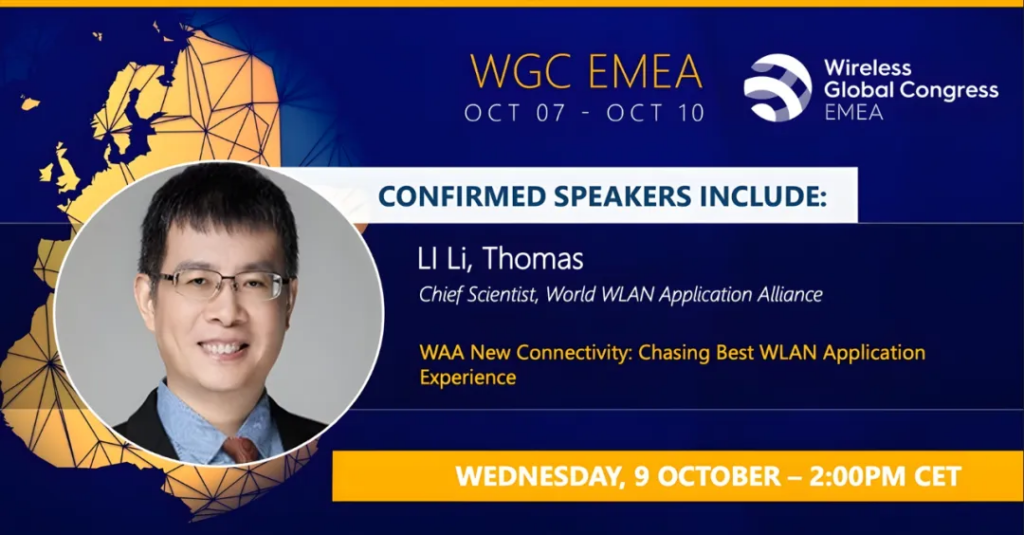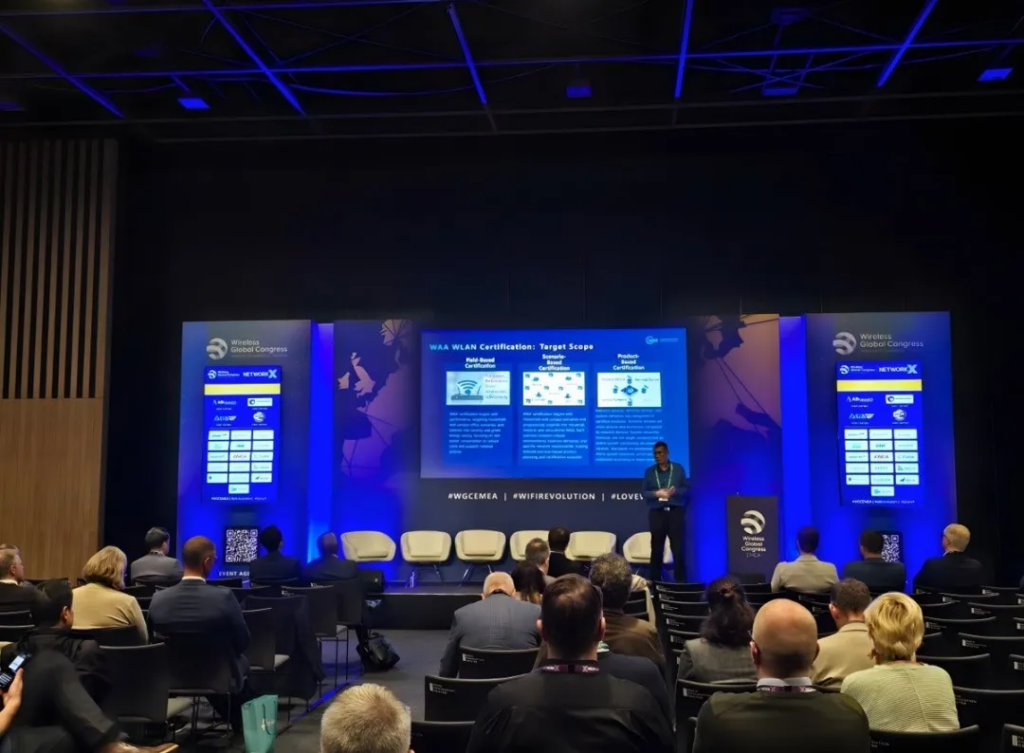WAA LI Li Shares Insights on WLAN Future at WGC EMEA 2024
2024-10-12
The following article comes from the WeChat Official Accounts——WAA联盟
WAA Chief Scientist LI Li Presents Visionary Insights at WGC EMEA 2024 on Future of WLAN Connectivity

Paris, October 9, 2024 – At the highly anticipated Wireless Global Congress (WGC) EMEA 2024, LI Li (Thomas), Chief Scientist of the World WLAN Application Alliance (WAA), delivered an insightful presentation titled “WAA NEW Connectivity: Chasing Best WLAN Application Experience.” As WAA’s Chief Scientist, Li highlighted the alliance’s ongoing efforts to promote sustainable and cutting-edge development in the WLAN industry, providing valuable insights into the current state and prospects of WLAN Application Experience Technology and Standard.
As part of WAA’s mission “to promote the healthy and sustainable development of the world WLAN industry and build the best WLAN application experience,” LI Li focused on the critical role of WLAN in the evolving connectivity landscape, emphasizing how it represents the voice of the global WLAN and short-range wireless industries.
WLAN at the Core of IoT Growth
LI Li’s presentation began with a compelling overview of the current trends in the Internet of Things (IoT) ecosystem. According to IoT Analytics, the total number of IoT connections reached 16.7 billion by the end of 2023, and this figure is projected to soar to 29.7 billion by the end of 2027. A significant 70% of these connections rely on short-range IoT technologies such as Wi-Fi, Bluetooth, and RFID. In contrast, long-range IoT technologies such as 5G, LoRa, and Sigfox account for less than 30% of total connections.
Of the short-range IoT technologies, those based on IEEE 802.11 (Wi-Fi) standards lead the pack, accounting for 31% of all IoT connections. Li Li’s analysis pointed out that WLAN remains the backbone of most IoT connectivity due to its adaptability, scalability, and cost-effectiveness.
Addressing WLAN Pain Points
LI Li also highlighted the ongoing challenges users face when interacting with WLAN technology across various settings. In-home networks, users often experience poor coverage and frequent network interruptions. In office networks, limited signal strength and unstable connection speeds can hinder productivity. Public networks, such as those found in cafes and airports, pose security risks with inadequate privacy protection and frequent threats of information leakage. Finally, in high-density environments like stadiums and concert venues, network congestion and insufficient bandwidth make reliable connections difficult to achieve.
These issues, according to Li, are major pain points that WAA aims to address through its standardization efforts and technological innovations. WAA’s commitment to improving the user experience, ensuring secure connections, and promoting efficient, low-latency WLAN networks is fundamental to the alliance’s mission.
Achieving the Best WLAN Application Experience
During the presentation, LI Li provided an in-depth analysis of the key factors that lead to an optimal WLAN application experience. These factors, including smooth connectivity, low packet loss, and minimal latency, are critical to the quality of WLAN performance. Li emphasized the importance of user-centric innovations, including seamless roaming, password-free login, and intelligent network operations that allow self-healing fault detection.
As part of WAA’s broader vision, Li underscored the alliance’s role in driving innovation across sectors. The alliance is actively developing solutions that reduce power consumption, enhance WLAN integration with other systems, and improve overall user convenience, aligning with the broader goals of green and sustainable technology development.
Why WLAN is Central to Future Connectivity
Li’s presentation made it clear that WLAN technology will play a pivotal role in supporting the IoT revolution. With over 70% of IoT connections relying on short-range technologies, WLAN is set to be a cornerstone of the future connectivity landscape. The expanding range of use cases – from home automation to smart cities, industrial IoT, and healthcare applications – underscores the need for robust, reliable, and secure WLAN networks.
As part of his address, Li explored the broader question: Why WLAN? He argued that WLAN’s flexibility, combined with the widespread adoption of Wi-Fi-enabled devices, makes it uniquely suited to meet the diverse needs of IoT ecosystems. Moreover, as IoT connections increase globally, Li emphasized the growing importance of standardization, collaboration, and certification in ensuring seamless, interoperable connectivity across different devices and networks.
The Importance of Industry Collaboration with WBA
As a gold sponsor of WGC EMEA 2024, hosted by WBA, WAA’s participation underscores its commitment to industry collaboration. LI Li noted that events like WGC EMEA play a crucial role in bringing together key stakeholders, including network operators, device manufacturers, service providers, and regulators. By participating in such events, WAA can share its expertise, promote its standards, and engage with a global audience of industry leaders.
When asked about the benefits of participating in industry events like WGC EMEA, Li stated, “These events provide an invaluable platform for WAA to connect with global experts, share our latest standards and research, and collaborate with other industry players to drive the adoption of WAA WLAN Application Experience Standard worldwide.”
LI Li’s keynote also touched on the value of WAA’s partnerships. With over 70 member organizations from 11 countries, WAA has established strategic collaborations with industry leaders like IEEE, WBA, and the Hong Kong Quality Assurance Agency. These partnerships have been instrumental in driving forward WAA’s agenda of creating a unified, global standard for WLAN Application Experience.
Future Prospects: Pioneering a New Era for WLAN
In his closing remarks, LI Li highlighted WAA’s vision for the future. The alliance is actively working on developing international standards and launching certification programs that will help ensure the interoperability and security of WLAN devices and networks. Li also pointed out WAA’s involvement in shaping the BRICS New Connectivity Sector International Cooperation Committee, which aims to strengthen international cooperation and raise the global profile of WAA WLAN Application Experience Standard.
Li concluded by stating, “WAA is at the forefront of driving the next phase of WLAN development. Our goal is to provide the best possible WLAN application experience, one that is intelligent, secure, and sustainable. We are committed to fostering an open and collaborative ecosystem that benefits all stakeholders across the WLAN industry.”
LI Li’s presentation at WGC EMEA 2024 was a highlight of the congress, offering valuable insights into the future of WLAN Application Experience Standard and its critical role in the IoT landscape. Through its participation in events like WGC EMEA, WAA continues to advance WAA Standard Certification, the symbol of quality, promote to experience Premium WLAN Applications and foster industry collaboration. With billions of new IoT connections expected in the coming years, WLAN Application Experience Standard will be at the heart of the digital transformation, providing the foundation for smarter, more connected environments.

